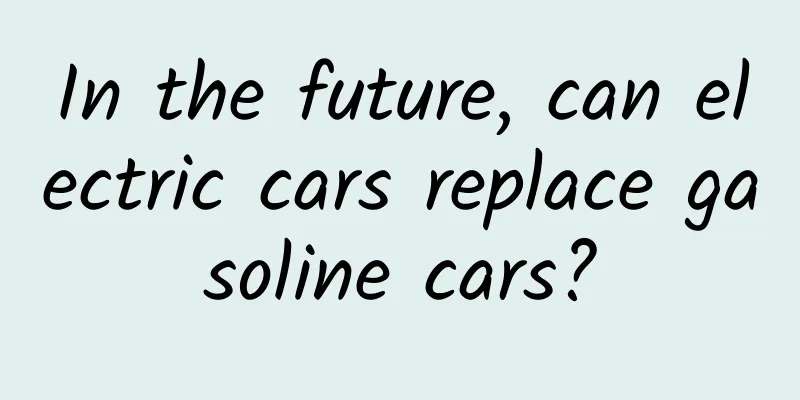In the future, can electric cars replace gasoline cars?

|
With the development of society and the advancement of science and technology, electric vehicles are becoming more and more popular, and there is a trend of overtaking gasoline and diesel vehicles. As a new energy vehicle, electric vehicles are divided into pure electric vehicles, hybrid electric vehicles, etc. according to the proportion of energy. Electric cars have been around for more than 170 years, even earlier than gasoline and diesel cars. What is less well known is that their development has been a long and tortuous journey, with interesting stories along the way. Sixty years of innovation and development One day in 1839, a Scottish businessman named Robert Anderson installed an electric motor and batteries on a three-wheeled carriage to facilitate the transportation of goods from home to the store, transforming it into the world's first electric-powered vehicle. The car could only travel about one kilometer at a time and was soon abandoned due to the poor battery life. Later, Robert donated it to a museum, where it was preserved intact and became the prototype of an electric car. The prototype of the electric car invented by American Anderson in 1839. Image source: Energy Network More than 20 years later, with the advent of lead-acid batteries, Austrian scientist Franz Kravogel demonstrated a two-wheeled electric car at the Paris World Expo. Although this car was powered by electricity, it was only for exhibition and was not put on the road or mass-produced, so it has always been considered an upgraded version of the prototype of electric cars. The first electric car recognized internationally was born in 1881. In order to test the effect of lead-acid batteries, a French engineer named Gustave Truff converted a human-powered tricycle into an electric car powered by lead-acid batteries. At the Paris International Electricity Exposition held at the end of 1881, Truffaut demonstrated the vehicle live and said that it would be put into mass production within three years. In 1884, Englishman Thomas Parker designed a battery with a larger capacity and was rechargeable. Trouff worked with him to use this new battery to create an electric car that could be mass-produced. The electric car invented by Parker and Truff, image source: First Electric Network History has given electric cars new opportunities. European countries, mainly France, Britain and Germany, have begun to pay attention to energy and environmental protection issues, and scientists have been engaged in the research, development and improvement of electric cars and batteries. Four years later, an engineer named Andre developed Germany's first electric car, which attracted the attention of many countries. Not wanting to lag behind, American William Morrison developed his country's first electric car in 1891. This six-passenger coach could reach a speed of 23 kilometers per hour, which is equivalent to the speed of today's electric cars (not electric cars). After several modifications, the new electric car was launched in 1894. At the end of the 19th century and the beginning of the 20th century, electric cars became popular in Europe and the United States, and quickly became on par with steam cars and gasoline cars in the automobile market. The three types of cars each have their own advantages and disadvantages: steam cars can travel long distances, but they need to store enough water, and it takes half an hour to warm up the engine each time; gasoline cars are moderately priced, but the internal combustion engine needs to be started by hand, and the exhaust gas produced during driving is unpleasant and the noise is extremely loud; electric cars start quickly, and do not produce exhaust gas and noise during driving, but the battery life is poor and the driving distance is short. Battery issues have always been a key factor that has plagued the development of electric vehicles. Scientists, including Edison, have been committed to researching batteries that can store more electricity. Car batteries are both inefficient and expensive, and electric cars have become a luxury. How long will this situation last? Ups and downs for ninety years Expensive electric cars dominated the auto market for just over a decade. Battery development was stagnant, while gasoline car development was booming. In the 1920s, the acceleration of oil extraction led to a gradual decline in gasoline prices. At the same time, the internal combustion engine of gasoline cars was successfully transformed, with electronic starting replacing hand cranking; the birth of silencers made noise disappear; and at the same time, exhaust emissions were effectively controlled. The above reasons have helped gasoline cars occupy the main automobile market, while electric cars have gone from having one-third of the market to almost extinction, and then gradually withdrawing from the stage of history. This withdrawal lasted for 40 years! In the early 1960s, Europe entered the mid-industrial age, and oil crises occurred in various countries. Electric vehicles once again attracted people's attention. In early 1960, American Motors Corporation and another company jointly developed a rechargeable electric car. The advent of this car promoted the development of electric vehicles. Pure electric vehicles quickly entered the market, and small electric vehicles were widely used in golf courses, etc. The electric golf car can reach a speed of 48 kilometers per hour. Image source: Energy Circle On July 31, 1971, the U.S. Apollo 15 placed an electric car on the moon. Each wheel of the car was equipped with a DC motor and a pair of silver-zinc-potassium hydroxide batteries. Various countries competed to report on it, and some media said that "electric cars will be the main means of transportation in the future." Electric cars parked on the moon, Image source: First Electric Network Unfortunately, the good times didn't last long. Plug-in electric cars are not suitable for long-distance driving, and they are even more difficult to drive in areas without charging stations. With the end of the oil crisis, gasoline cars quickly became popular and dominated the car market for nearly 20 years. During this period, the number of electric cars in the market accounted for less than 10%. From 1900 to 1990, the development of electric vehicles has experienced ups and downs over the past 90 years, a long and tortuous journey. Comprehensive application for twenty years Since the 1990s, humanity has gradually deepened its understanding of issues such as global warming caused by exhaust gas from gasoline and diesel vehicles and limited oil resources, and the research and development of electric vehicles has once again attracted the attention of countries around the world. Since then, battery research and development has made great progress, and the range of electric vehicles has also been improved to 50-80 kilometers per hour, basically meeting people's travel needs. At the end of 1995, the first batch of innovative electric cars came out in Europe. In the following five years, the number of electric cars in Europe more than doubled to 16,255, with France, Switzerland and Germany ranking the top three in terms of ownership (according to the European Urban Electric Vehicle Association). In the early 21st century, Tesla Motors of the United States used lithium-ion batteries produced by Panasonic to develop the unique Tesla car. The first fully automatic pure electric Tesla car was born in 2008 and can travel 320 kilometers on a full charge. Tesla has sold thousands of electric cars in more than 10 years. The advent of Tesla electric cars marked the beginning of a new era for electric cars. Since then, electric cars have developed rapidly. As of September 2015, global sales of plug-in electric buses, electric trucks, and electric vehicles totaled 1 million, with pure electric vehicles accounting for about 62% of total sales. Although electric vehicles only account for a part of the automobile market at present, their high popularity will be an unstoppable trend in the future. At the same time, based on the great advantages of electric vehicles in terms of cost and performance, coupled with the attention of governments around the world to climate change and environmental protection, in the near future, electric vehicles are expected to surpass or even replace gasoline vehicles. Sales volume of electric vehicles in major countries around the world over the years, Image source: see watermark my country's new energy vehicle industry, which is mainly electric vehicles, has just experienced more than 20 years. In 2001, the new energy vehicle research project was included in the national "15th Five-Year Plan" development plan, with the specific steps of "starting from gasoline vehicles and moving towards hydrogen-powered vehicles". my country has stepped up efforts to promote the development of electric vehicle technology and the implementation of electric vehicle products. It has now become the country with the largest number of electric vehicles in the world and the second largest electric vehicle market in the world. References: 1. Luo Wenyun, Zhou Hao, Yu Letao, et al., “The Current Status and Optimization Suggestions of Electric Vehicle Development at Home and Abroad”, China Collective Economy, No. 2, 2018 2. Fan Yuhong, Zhang Wei, Chen Yang, “Analysis of the Development of Electric Vehicles Abroad and Its Implications for my country”, Huazhong Electric Power, No. 23, 2010 END Tadpole Musical Notation original article, please indicate the source when reprinting Editor/Xiao Xitushuo |
<<: His life goal is to obey the needs of the country, but why did he refuse promotion twice?
Recommend
Douyin mini-game blue ocean project, earning 5000+ a day without fans
The 15th strategy of the three crazy demolishers ...
Green plums, the ultimate romance of the Chinese people
Written by Wei Shuihua The Latin scientific name ...
Xiaomi Tablet running score test: Tegra K1 is indeed not exaggerated
Yesterday afternoon, Xiaomi officially released th...
How to plan an efficient APP marketing operation plan
In recent years, mobile Internet has developed ra...
[Tools] Recommend 8 promotion and operation tools commonly used by experts, you must know!
In the eyes of most operators , operations are di...
SEO money-making industry project case: How to use long-tail keywords to earn 100,000 yuan a month?
When it comes to SEO , many people may think it i...
How to avoid "playing the lute to a cow" in traffic promotion?
Who are you asking for traffic from? In ancient t...
Let the data speak for itself: What will be the next phenomenal APP?
The explosion of WeChat public accounts has broug...
How much does it cost to rent a server in Shanghai IDC computer room for one year?
Shanghai is a first-tier city in China, where hou...
How to acquire a large number of accurate users at low cost?
In 2017, the operation method of increasing fans ...
Optimization strategy for B station video native advertising
As a cultural community and video platform where ...
What are the reasons for the poor results of Baidu’s bidding promotion?
Customers often visit the official website to inq...
How did Microsoft lose to Google in mobile phone systems? Microsoft actually missed these opportunities
Speaking of the Microsoft mobile phone system bac...
Falkirk Ship: A "special elevator" designed for ships
With the advent of elevators, our lives have beco...
How to get more customers smartly?
If we divide the company's customer base base...









